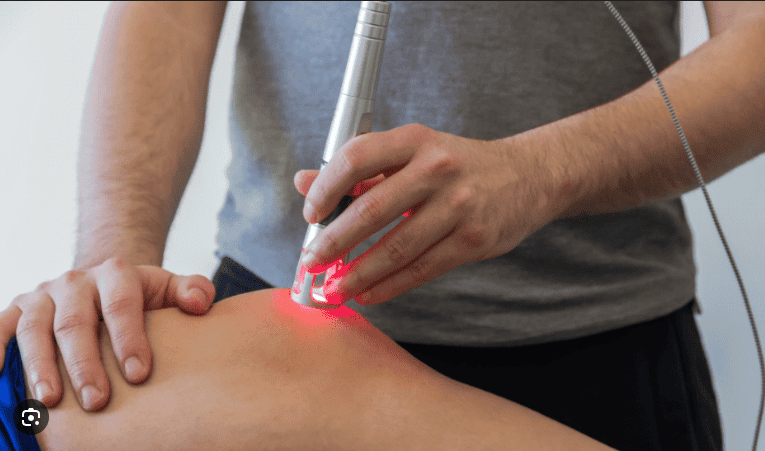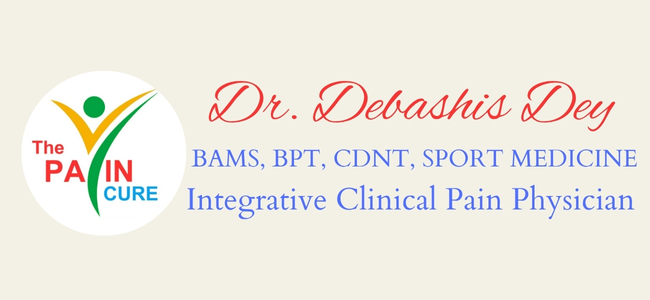Laser Treatment

Low-Level Laser Therapy (LLLT), also known as Cold Laser Therapy, is a non-invasive, painless, and highly effective treatment modality used in pain management and rehabilitation.
It works by delivering specific wavelengths of light energy to targeted tissues. These light photons penetrate the skin and are absorbed by the cells, initiating photobiomodulation, which triggers various biological processes that promote healing, reduce pain, and restore normal function.
1. Photobiomodulation at the Cellular Level
The core mechanism of LASER therapy lies in the absorption of light energy by mitochondria, the “powerhouse” of cells. The photons from the LASER are absorbed by cytochrome c oxidase, an enzyme involved in the electron transport chain.
This process enhances the production of ATP (Adenosine Triphosphate), which fuels cellular repair and regeneration. Increased ATP leads to faster tissue healing, reduced oxidative stress, and improved cell metabolism.
Result: Damaged tissues recover more quickly, leading to long-term pain relief and restoration of normal function.
2. Reduction of Inflammation
Inflammation is one of the primary causes of both acute and chronic pain. LASER therapy has a strong anti-inflammatory effect: It decreases pro-inflammatory mediators like TNF-α, IL-1β, and prostaglandins.
It promotes the release of anti-inflammatory cytokines, balancing the immune response. Reduces tissue edema (swelling) by improving lymphatic drainage.
Result: Faster reduction of swelling, stiffness, and pain in conditions like arthritis, tendonitis, and sports injuries.
3. Pain Signal Modulation (Analgesic Effect)
LASER therapy directly influences the nervous system to reduce pain perception: It stabilises nerve membrane potential, decreasing abnormal nerve firing responsible for neuropathic pain.
Stimulates the release of natural pain-relieving chemicals like endorphins and enkephalins. Blocks the transmission of pain signals to the brain by affecting C-fibre nerve activity.
Result: Immediate pain relief without drugs or invasive procedures.
4. Improved Blood Circulation and Oxygen Supply
LASER light causes vasodilation, which improves local blood circulation. Increases oxygen delivery and nutrient supply to the damaged area. Enhances the removal of waste products such as lactic acid and inflammatory toxins. Speeds up the body’s natural healing process.
Result: Improved tissue repair and decreased stiffness, especially beneficial for chronic pain and degenerative conditions.
5. Stimulation of Tissue Repair and Regeneration
LASER therapy stimulates fibroblast activity, which is essential for collagen production. It accelerates the repair of muscles, ligaments, tendons, and cartilage. Helps in the regeneration of nerves and soft tissues, making it valuable in conditions like sciatica and neuropathy.
Result: Long-term improvement in joint mobility and muscle strength.
6. Neuromodulation and Relaxation Effect
Chronic pain often causes muscle spasms and stress.LASER promotes parasympathetic nervous system activation, leading to relaxation. Relieves muscle tension and cramps. Improves sleep quality and overall sense of well-being.
Clinical Applications
LASER therapy is widely used for:
- Low Back Pain and Cervical Spondylosis
- Arthritis and Osteoarthritis
- Sports Injuries (ligament sprain, muscle strain)
- Neuropathic Pain (sciatica, carpal tunnel syndrome)
- Post-surgical Pain and Healing
P.E.M.F

Pulsed Electromagnetic Field (PEMF) therapy is a non-invasive, safe, and effective modality used in pain management and rehabilitation. It works by delivering gentle, time-varying electromagnetic fields to the body, which penetrate deep into tissues, muscles, joints, and even bones, stimulating cellular repair and restoring normal physiological functions. The mechanism of action of PEMF is based on its interaction with the body’s natural bioelectrical and biochemical processes.
1. Cellular Level Action
PEMF therapy works at the cellular level by influencing the cell membrane potential. Pain and inflammation often occur due to disrupted cellular activity caused by injury or disease.
PEMF restores the normal transmembrane potential by stimulating ion exchange, especially sodium, potassium, and calcium channels. This helps improve oxygen uptake, ATP (adenosine triphosphate) production, and overall cellular energy.
Increased ATP accelerates tissue repair and regeneration. Enhanced mitochondrial activity promotes faster healing of damaged tissues.
2. Improved Blood Circulation and Oxygenation
PEMF causes vasodilation by stimulating the production of nitric oxide, a natural vasodilator. This improves microcirculation and enhances oxygen delivery to injured or painful areas.
Better blood flow aids in removing metabolic waste products such as lactic acid and inflammatory mediators, thereby reducing swelling, stiffness, and pain. This mechanism is particularly beneficial in chronic pain conditions like arthritis, low back pain, and neuropathic pain.
3. Anti-Inflammatory Effect
Inflammation is a key contributor to pain. PEMF helps in modulating inflammatory responses by reducing pro-inflammatory cytokines (e.g., TNF-α, IL-1β) and increasing anti-inflammatory cytokines.
It stabilises cell membranes, reducing edema and swelling. By normalising the inflammatory process, PEMF helps in both acute injuries and chronic inflammatory conditions like tendonitis or bursitis.
4. Pain Signal Modulation
PEMF influences nerve conduction by regulating ion flow across nerve membranes. This leads to: Decreased excitability of overactive pain nerves. Reduction of abnormal nerve firing responsible for neuropathic pain.
Stimulation of the body’s natural pain-relieving chemicals like endorphins and enkephalins. This is similar to the “gating mechanism” in TENS therapy, but works deeper and longer-lasting.
5. Bone and Soft Tissue Healing
PEMF is FDA-approved for non-union bone fractures. It stimulates osteoblast activity, enhancing bone mineralisation and density. For soft tissues such as tendons, ligaments, and muscles, It promotes collagen production. Accelerates fibroblast proliferation. Improves tissue elasticity and strength, which helps prevent future injuries.
6. Neuromodulation and Relaxation
Chronic pain is often associated with muscle spasms and nerve irritation. PEMF has a calming effect on the autonomic nervous system by promoting parasympathetic activity, which: Relieves muscle tension and spasms. Reduces stress and anxiety associated with chronic pain. Enhances overall well-being and sleep quality.
